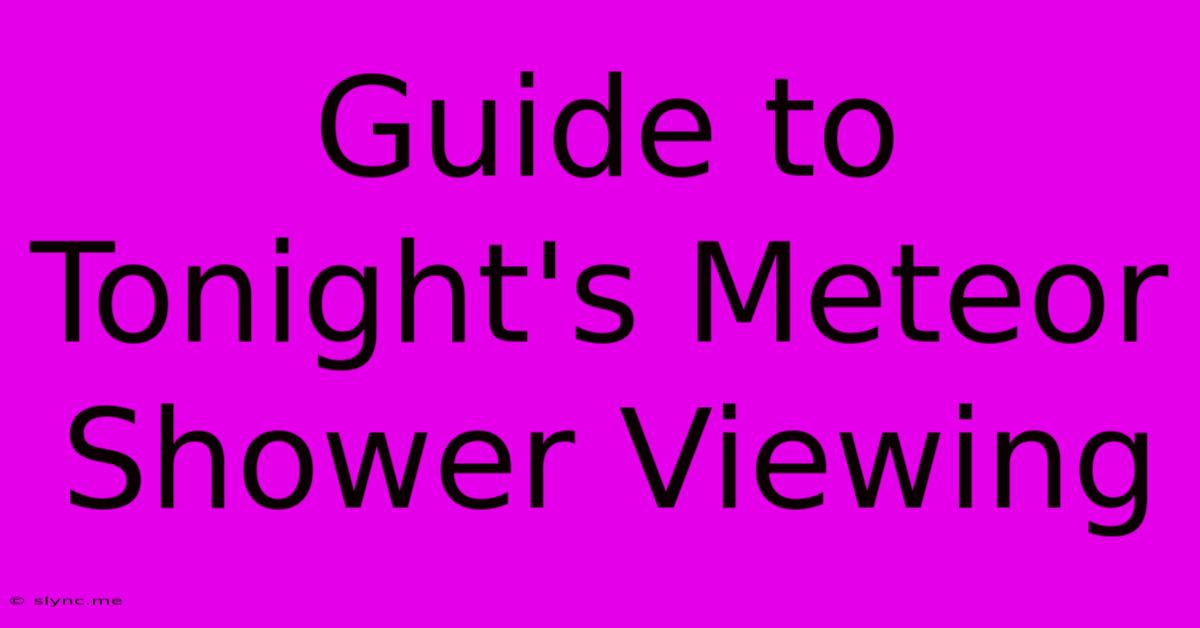Guide To Tonight's Meteor Shower Viewing

Discover more detailed and exciting information on our website. Click the link below to start your adventure: Visit Best Website Mrs.Amykhan. Don't miss out!
Table of Contents
Guide to Tonight's Meteor Shower Viewing: Maximize Your Celestial Experience
Are you ready for a breathtaking celestial spectacle? Tonight's meteor shower promises to be a truly unforgettable event, and this guide will help you make the most of it. Whether you're a seasoned stargazer or a curious beginner, we'll cover everything you need to know to witness the magic of shooting stars.
Understanding Tonight's Meteor Shower
Tonight's meteor shower is a [Name of Meteor Shower, e.g., Perseid meteor shower], originating from [Source of the meteor shower, e.g., the debris trail of the comet Swift-Tuttle]. This particular shower is known for its [Characteristics of the shower, e.g., bright and fast meteors, long trails]. The peak viewing time is expected to be between [Start Time] and [End Time] in your local time zone. The radiant point – the area of the sky from which the meteors appear to originate – will be located near the constellation [Constellation Name].
Key Facts for Optimal Viewing:
- Peak Activity: [Time of peak activity, be specific]
- Expected Rate: [Number] meteors per hour (under ideal conditions).
- Best Viewing Location: [Hemisphere, e.g., Northern Hemisphere].
Essential Gear for Meteor Shower Watching
While you don't need expensive equipment, some tools will significantly enhance your experience:
- A Dark Location: Light pollution is the biggest enemy of meteor shower viewing. Escape city lights and find a location with minimal artificial illumination. Dark sky parks or rural areas are ideal.
- A Comfortable Reclining Chair or Blanket: You'll be looking upwards for extended periods, so comfort is key.
- Warm Clothing: Even summer nights can get chilly, especially if you're staying out late. Dress in layers.
- Red Flashlight: A red light preserves your night vision better than a white light. You can easily cover a standard flashlight with red cellophane.
- A Star Chart or App: While not strictly necessary, a star chart or astronomy app (like Stellarium or SkySafari) can help you locate the radiant point and identify constellations.
Maximizing Your Meteor Shower Experience
- Arrive Early: Give yourself ample time to adjust to the darkness and let your eyes become fully accustomed to the low light levels. This will significantly improve your ability to see fainter meteors.
- Be Patient: Meteor showers aren't like watching a fireworks display. There will be lulls between bursts of activity. Relax, be patient, and enjoy the overall experience.
- Look Beyond the Radiant Point: While the meteors appear to emanate from the radiant point, you'll see more meteors by looking at a wider area of the sky.
- Check the Weather Forecast: Clouds can completely obscure the view. Check the forecast before you go and choose a clear night.
- Share the Experience: Bring friends and family along to share in the wonder of the night sky.
Safety First: Important Reminders
- Never look directly at the sun. This can cause serious eye damage.
- Be aware of your surroundings. Avoid dangerous areas and be mindful of wildlife.
- Let someone know where you're going and when you expect to be back.
- Drive carefully if you're traveling to a dark sky location.
Beyond Tonight's Shower: Planning for Future Celestial Events
Tonight's meteor shower is just one of many incredible celestial events throughout the year. Keep an eye on astronomy websites and apps for information about upcoming meteor showers, eclipses, and other astronomical phenomena. Happy stargazing!

Thank you for visiting our website wich cover about Guide To Tonight's Meteor Shower Viewing. We hope the information provided has been useful to you. Feel free to contact us if you have any questions or need further assistance. See you next time and dont miss to bookmark.
Also read the following articles
| Article Title | Date |
|---|---|
| Arrest Warrant Issued For Allu Arjun | Dec 13, 2024 |
| Gra Roku 2024 Astro Bot Zdobuv Peremogu | Dec 13, 2024 |
| Hadley Bids Adieu After 43 Years | Dec 13, 2024 |
| Svyato V Epic Games Store Znizhki | Dec 13, 2024 |
| Molan Breaks Silence On Radio Tv Dismissal | Dec 13, 2024 |
